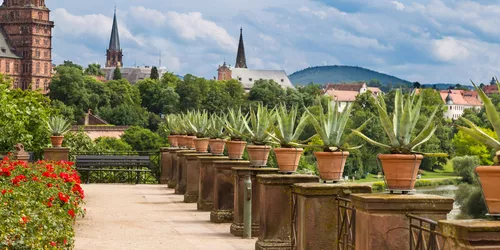The Pompejanum in Aschaffenburg: an insight into antiquity
From the Gulf of Naples to the Main: the "Pompejanum" in Aschaffenburg is a window into the art and culture of antiquity. Changing exhibitions and exciting guided tours await you in the authentically modelled Roman villa.

King Ludwig I and his "Bavarian Nice"
For King Ludwig I, Aschaffenburg was more than just a town - he enthusiastically referred to it as the "Bavarian Nice". Due to the mild climate, the art-loving monarch made the town on the River Main his summer residence. One of the most impressive buildings from this period is the Pompejanum, which was modelled on the "Casa dei Dioscuri", a Pompeian town villa. The museum is enthroned above the vineyards along the River Main and is just a ten-minute walk from Aschaffenburg's main railway station.
Architectural masterpiece with a special lighting system
The Pompejanum also has some special architectural features. The "natural" lighting system is particularly impressive: the building itself is almost windowless. It receives light almost exclusively via the two inner courtyards - and through the reflection of light in the atrium. The atrium itself is also a small work of art: flanked by long columns and decorated with mosaic floors, this rectangular room, typical of Roman architecture, has a ceiling adorned with numerous images of imaginative mythical creatures.
Original insights into the world of antiquity
Inside, you will find evidence of times long past. The permanently exhibited objects include original bronze and marble sculptures, as well as small works of art and everyday objects. They provide a deep insight into the world of life and beliefs in ancient Rome. The large-format wall frescoes in the Pompeian style bring the splendour of Roman patrician villas back to life. In addition, regular special exhibitions are always a welcome reason to visit the Pompeianum more than once. For those who want to delve even deeper into the subject matter, the museum offers a wide range of paid overview and themed tours for adults, as well as a free guided tour via smartphone aimed specifically at children aged six to ten.
Current information, admission prices and opening times can be found here.
Panoramic view over the Franconian vineyards
Visitors to the Pompejanum in Aschaffenburg should not miss the view from the viewing pavilion on the second floor: From here you have an impressive view over the Franconian vineyards, the river promenade and a Mediterranean-style garden area. Between cedars, agaves, fig and almond trees, you can enjoy the mild scent of the south: the "Bavarian Nice" sends its regards.
Johannisburg Castle: well worth a detour
Very close to the Pompejanum, just 13 minutes away, another impressive building awaits discovery: Johannisburg Castle. The four-winged complex, one of the most important palace buildings of the German Renaissance, was the secondary residence of the elector-bishops of Mainz until 1803. The world's largest collection of cork-made architectural models is well worth a visit: Johannisburg Palace houses 45 replicas of buildings from ancient Rome, created between 1792 and 1854.
Culinary finale in the Kitz wine bar
For a successful end to the day, we recommend dinner at the Weinstube Kitz, which is located almost halfway between the Pompejanum and the railway station and practically on the way home. It is only a five-minute walk from Johannisburg Castle. The wine tavern offers hungry day trippers regional and seasonal dishes at reasonable prices in a historic setting. The listed inn has existed in the centre of Aschaffenburg since 1803.
How to get there: How to get to the Pompejanum
Take the train to Aschaffenburg. From Aschaffenburg main station, you can reach the Pompejanum in just under ten minutes. Leave Aschaffenburg station in the direction of Ludwigstraße, then follow the road to the west on the right and after about 300 metres turn left into Kolpingstraße. After a few minutes, cross Hanauerstraße and continue along Karlstraße. After about 50 metres, Karlstraße becomes Kapuzinerplatz, continue straight ahead and follow the road to the right. You will reach a spacious garden, which you can cross on a narrow path and at the end of which is the Pompejanum.
Getting to the Kitz wine tavern
On the way to Weinstube Kitz from the Pompejanum, follow the narrow path through the garden again until you reach Kapuzinerstraße. Follow this street until Karlsstraße turns off to the right. Turn into it and follow Karlsstraße for around 160 metres. Then turn left onto Erthalstraße and immediately turn right again onto Agathaplatz-Straße. After 60 metres, the road turns into Treibgasse. Your destination, the Weinstube Kitz, is on the right-hand side.
From Schloss Johannisburg, cross Schlossplatz and follow Luitpoldstraße for 130 metres until you reach Treibgasse on the left. Turn into Treibgasse and after 120 metres you will reach the restaurant.
Arrival
Pompejanumstraße 5
63739 Aschaffenburg
Aschaffenburg Hbf
Our tip: Please make sure to check your train connection and the expected capacity before you start your journey.




